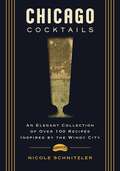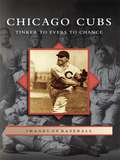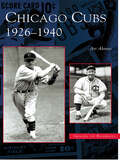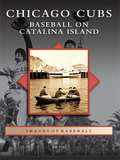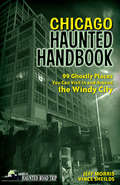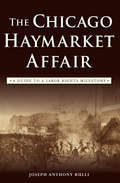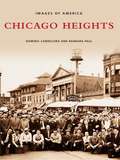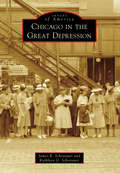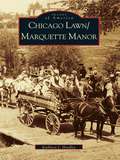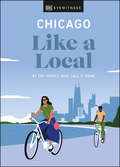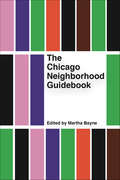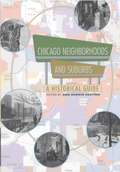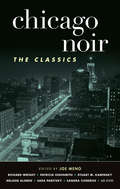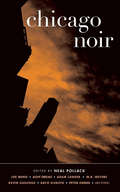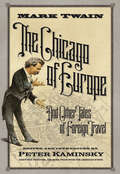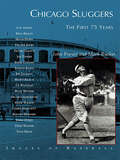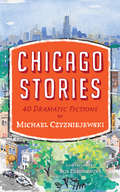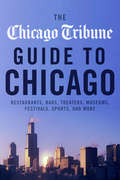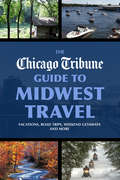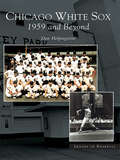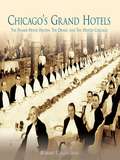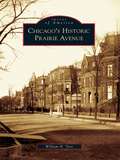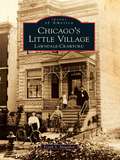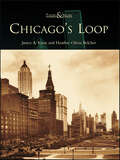- Table View
- List View
Chicago Cocktails: An Elegant Collection of Over 100 Recipes Inspired by the Windy City
by Nicole SchnitzlerAn elegant collection of over 100 recipes inspired by Chicago.From fruity juleps to creamy sours and old school martinis, these signature recipes from Chicago hotspots pay homage to the Windy City. With over 100 recipes and dozens of bartender profiles, you can drink like a local wherever you are. This book is broken down by neighborhood, so you can find the best bars and finest signature creations that Vancouver has to offer. Residents and tourists alike will discover locations and drinks that are sure to satisfy all tastes.Within the gorgeous, die-cut covers, you'll find:More than 100 essential and exciting cocktail recipes, including recipes for bespoke ingredients and other serving suggestionsInterviews with the city&’s trendsetting bartenders and mixologistsBartending tips and techniques from the expertsFood and drink destinations across the cityAnd much more!Get a taste of Chicago's craft cocktail scene without ever leaving your zip code with Chicago Cocktails.
Chicago Cubs: Tinker to Evers to Chance (Images of Baseball)
by Art AhrensIt has been a long time. Joe Tinker, Johnny Evers, and Frank Chance--that "trio of bear cubs" immortalized in poem and enshrined as a unit in Cooperstown--formed the core of a ball club that brought Chicago baseball fans backtoback World Series championships 100 years ago. And fans are still waiting for victory number three. Chicago Cubs: Tinker to Evers to Chance brings the reader back to the notsohalcyon days of spitball pitchers, insidethepark home runs, and an era when raucous fans lined the foul lines, often a little too close for comfort for the visiting ballplayers. Beginning in 1898 with the acquisition of a green Frank Chance and following the team's exploits through the 1916 season, the last for Joe Tinker in a Cubs uniform, this is the story of Wrigleyville's favorite tenants, before there was a Wrigleyville.
Chicago Cubs: 1926-1940 (Images of Baseball)
by Art AhrensThe Chicago Cubs of the mid-1920s through 1940 were one of the most talented and exciting ball clubs the city ever produced. The Northsiders enjoyed 14 consecutive winning seasons and claimed the National League pennant four times (1929, 1932, 1935, and 1938), but fell to a dominant American League club in each World Series appearance. Four legendary baseball names led these Cub teams during this amazing stretch. Three eventually landed in Cooperstown (McCarthy, Hornsby, Hartnett), and many believe the fourth (Grimm) should have joined them. This was also the era when Cubs Park was transformed into Wrigley Field, under the guidance of Bill Veeck Jr., with its trademark bricks and ivy, hand-operated scoreboard, and outfield bleachers.
Chicago Cubs: Baseball on Catalina Island (Images of Baseball)
by Jim VittiIt's not quite like today's spring training: one might find a rookie ballplayer (nicknamed Hack) uprooting trees with his bare hands or a future president of the United States getting into a barroom brawl with some grizzled sportswriters. The team was the Chicago Cubs, and the place was Santa Catalina Island-through the Roaring Twenties, Great Depression, and World War II. William Wrigley owned both island and ballclub; from 1921 to 1951, they came together. There were movie stars, like Betty Grable and Marilyn Monroe. There were grand steamships, big bands, hopes and dreams, and World Series rings. It's Chicago Cubs: Baseball on Catalina Island, and it's a trip like no other.
Chicago Haunted Handbook
by Jeff Morris Vince SheildsChicago Haunted Handbook is the newest book in the Haunted Handbook line within the popular America's Haunted Road Trip series. The Haunted Handbooks are city-specific travel guides to nearly one hundred places within a major city.Chicago Haunted Handbook is written with the ghost enthusiast in mind. All 100 chapters contain information on the history as well as the haunting surrounding each location, as well as detailed directions on how to locate each site. Many of the chapters also contain insider information that only a local would know, making it easier for ghost hunters to investigate. Ghost hunters Jeff Morris and Vincent Sheilds explore all the best haunted locales Chicago has to offer, including Resurrection Cemetery, Bachelor's Grove Cemetery, Murder Castle, St. Valentine's Day Massacre Site, and even Wrigley Field.Each two page entry includes directions from downtown, an historical overview of the haunted place, the story of ghostly doings in that place, and advice on visiting the place yourself--if you dare.
The Chicago Haymarket Affair: A Guide to a Labor Rights Milestone
by Joseph Anthony RulliThis history and guide presents the significant sites and events of the Haymarket Square riot, a major turning point in the fight for workers&’ rights. On May 4th, 1886, a bomb exploded during a labor demonstration near Haymarket Square in Chicago. The ensuing gunfire and chaos brought a grisly end to what began as peaceful support for an eight-hour workday. With both officers and civilians dead, newspapers proclaimed an anarchist conspiracy. The investigation led to the trial and execution of rally organizers. The incident also drew irrevocable attention to debates about workers&’ rights and the role of law enforcement that continues today. In this guide to the key moments and sites of one of Chicago&’s most confusing and chaotic events, author Joseph Anthony Rulli aims to establish a clearer understanding of its historical significance.
Chicago Heights
by Barbara Paul Dominic CandeloroChicago Heights is a multicultural tableau, depicting the story of nineteenth-century pioneers and twentieth-century workers who built one of the most vibrant of the small, industrial cities of the Midwest. The exciting collection featured here is a result of an intensive city-wide campaign to identify the very best photographs of old Chicago Heights.About half came from the extensive collections of the Public Library and the Historical Society, while the rest were borrowed from local residents. This fascinating compilation features various past and present residents of Chicago Heights, a look at its diverse ethnic groups and religious denominations, and glimpses of old downtown buildings that no longer exist. The city's church groups, ethnic clubs, businesses, factories, and transportation facilities are all pictured here. Along with detailed captions, Chicago Heights offers the rare chance to experience the history of old Chicago Heights, bringing its exciting past alive again.
Chicago in the Great Depression
by James R. Schonauer Kathleen G. SchonauerCarl Sandburg called Chicago the "City of the Big Shoulders," and those shoulders withstood the stock market crash of 1929. Chicagoans rallied to collect funds to celebrate the centennial of the city's incorporation in 1833. A Century of Progress International Exposition, held in 1933 and 1934, brought jobs and businesses to Chicago and cheered people with the prospect of new technology and the promising face of the future. Neighborhood churches and community organizations helped each other, and the Great Migration brought new arrivals from the American South. Together, these factors helped to hasten the end of Prohibition and the fall of notorious gangsters like Al Capone and John Dillinger. Jazz rolled in, with Chicagoans dancing along to the tunes of the big bands. Even if pocketbooks were bare, souls were full of hope.
Chicago Lawn/Marquette Manor (Images of America)
by Kathleen J. HeadleyThe Marquette Park area on the southwest side of Chicago is comprised of two neighborhoods- Chicago Lawn and Marquette Manor. This book depicts the evolution of both neighborhoods with photographs and images of the earliest developments, buildings, and families-some of which have been professionally reproduced from original glass slides-beginning in 1876 with the arrival of John F. Eberhart, the "Father of Chicago Lawn." Due focus is paid to the common denominator and centerpiece of both communities-Marquette Park. Beginning with early photographs of this popular 323-acre park and golf course, Chicago Lawn/Marquette Manor takes the reader through its grand beginnings as "the playground of the Southwest Side," and features activities throughout the years, including the racial strife it unfortunately acquired national notoriety for. The reader will have the opportunity to peek inside Amos Cravener's grocery store and H.E. Cain's pharmacy, c. 1900, as well as walk down 63rd Street when it was surrounded by prairie, watch as new buildings appear, and return when it is fully populated.
Chicago Like a Local: By the People Who Call It Home (Local Travel Guide)
by DK Eyewitness Amanda Finn Meredith Paige Heil Nicole SchnitzlerKeen to explore a different side of Chicago? Like a Local is the book for you.This isn&’t your ordinary travel guide. Beyond the sporting stadiums and skyscrapers, you'll find vegan diners, late-night comedy clubs and third-wave coffee shops – and that&’s where this book takes you. Turn the pages to discover:- The small businesses and community strongholds that add character to this vibrant city, recommended by true locals.- 6 themed walking tours dedicated to specific experiences such as record stores and dive bars. - A beautiful gift book for anyone seeking to explore Chicago.- Helpful &‘what3word&’ addresses, so you can pinpoint all the listed sights.Compiled by three proud locals, this stylish travel guide is packed with Chicago&’s best experiences and secret spots, handily categorized to suit your mood and needs.Whether you&’re a restless Chicagoan on the hunt for a new hangout, or a visitor keen to discover a side you won&’t find in traditional guidebooks, Chicago Like A Local will give you all the inspiration you need. About Like A Local:These giftable and collectible guides from DK Eyewitness are compiled exclusively by locals. Whether they&’re born-and-bred or moved to study and never looked back, our experts shine a light on what it means to be a local: pride for their city, community spirit and local expertise. Like a Local will inspire readers to celebrate the secret as well as the iconic – just like the locals who call the city home. Looking for another guide to Chicago? Explore further with our DK Eyewitness or Top 10 guides to Chicago.
The Chicago Neighborhood Guidebook (Belt Neighborhood Guidebooks)
by Martha BaynePart of Belt's Neighborhood Guidebook Series, The Chicago Neighborhood Guidebook is an intimate exploration of the Windy City's history and identity. "Required reading"-- The Chicago Tribune Officially,
Chicago Neighborhoods and Suburbs: A Historical Guide
by Ann Durkin Keating"Which neighborhood?" It's one of the first questions you're asked when you move to Chicago. And the answer you give--be it Bucktown, Bronzeville, or Bridgeport--can give your inquisitor a good idea of who you are, especially in a metropolis with 230 very different neighborhoods and suburbs to choose from. Many of us, in fact, know little of the neighborhoods beyond those where we work, play, and live. This is especially true in Chicagoland, a region that spans over 4,400 square miles and is home to more than 9. 5 million residents. In Chicago Neighborhoods and Suburbs, historian Ann Durkin Keating sheds new light on twenty-first-century Chicago by providing a captivating yet compact guide to the Midwest's largest city. Keating charts Chicago's evolution with comprehensive, cross-referenced entries on all seventy-seven community areas, along with many suburbs and neighborhoods both extant and long forgotten, from Albany Park to Zion. Thoughtful interpretive essays by urban historians Michael Ebner, Henry Binford, Janice Reiff, Susan Hirsch, and Robert Bruegmann explore how the city's communities have changed and grown throughout the years, and sixty historic and contemporary photographs and additional maps add depth to each entry. From the South Side to the West Side to the North Side, just about every local knows how distinctive Chicago's neighborhoods are. Few of us, however, know exactly how they came to be. Chicago Neighborhoods and Suburbs brings the city--its inimitable neighborhoods, industries, and individuals--to life, making it the perfect guidebook for anyone with an interest in Chicago and its history.
Chicago Noir: The Classics (Akashic Noir #0)
by Harry Stephen Keeler Sherwood Anderson Max Allan Collins Richard Wright Nelson Algren Fredric Brown Patricia Highsmith Barry Gifford Stuart M. Kaminsky Libby Fischer Hellmann Sara Paretsky Percy Spurlark Parker Sandra Cisneros Hugh Holton Stuart Dybek"In this superior entry in Akashic's noir series, Meno offers nearly a century of Chicago crime fiction....Familiar bylines abound: Max Allan Collins, Richard Wright, Nelson Algren, Sherwood Anderson, Fredric Brown, Patricia Highsmith (with an excerpt from her novel The Price of Salt), Stewart M. Kaminsky, Sara Paretsky. Others may be less familiar to mystery specialists, but all turn in impressive performances."--Publishers Weekly, Starred review"Richard Wright, Nelson Algren, and Sandra Cisneros are not crime-fiction writers, and yet their Chicago certainly embodies the individual-crushing ethos endemic to noir. Meno also includes stories from writers who could easily have been overlooked (Percy Spurlark Parker, Hugh Holton) to ensure that diverse voices, and neighborhoods, are represented. Add in smart and essential choices from Fredric Brown, Sara Paretsky, and Stuart Kaminsky, and you have not an anthology not for crime-fiction purists, perhaps, but a thought-provoking document all the same."--Booklist"The fifteen short stories comprising Chicago Noir: The Classics, which are knowledgeably compiled and deftly edited by Joe Meno, are true gems of the noir literary tradition....Chicago Noir: The Classics is a consistently entertaining and will prove to be an enduringly popular addition to community library Mystery/Suspense collections."--Midwest Book Review"I've always enjoyed reading noir. Dark, ironic mysteries are a good read to me. Since this collection includes old classics as well as some new stories, I knew it would be good....I wasn't disappointed."--Journey of a Bookseller"Chicago Noir The Classics does everything anthologies and noir are supposed to, but this title achieves an unheralded goal that deserves notice....This is wonderful diversity, coming both unexpected and unhearalded. Anthologies are supposed to convey a sense of having covered the territory, Joe Meno has. Ethnically diverse city, ethnically diverse plots. Better, Chicago Noir The Classics showcases diversity as normal, everyday. This adds inescapable satisfaction to a sense of the editor's having covered the territory."--La Bloga"A worthy addition to the Akashic Books noir series."--Book ChaseAlthough Los Angeles may be considered the most quintessentially "noir" American city, this volume reveals that pound-for-pound, Chicago has historically been able to stand up to any other metropolis in the noir arena.Classic reprints from: Harry Stephen Keeler, Sherwood Anderson, Max Allan Collins, Richard Wright, Nelson Algren, Fredric Brown, Patricia Highsmith, Barry Gifford, Stuart M. Kaminsky, Libby Fischer Hellmann, Sara Paretsky, Percy Spurlark Parker, Sandra Cisneros, Hugh Holton, and Stuart Dybek.From the introduction by Joe Meno:"More corrupt than New York, less glamorous than LA, Chicago has more murders per capita than any other city its size. With its sleek skyscrapers bisecting the fading sky like an unspoken threat, Chicago is the closest metropolis to the mythical city of shadows as first described in the work of Chandler, Hammett, and Cain. Only in Chicago do instituted color lines offer generation after generation of poverty and violence, only in Chicago do the majority of governors do prison time, only in Chicago do the dead actually vote twice."Chicago--more than the metropolis that gave the world Al Capone, the Saint Valentine's Day Massacre, the death of John Dillinger, the crimes of Leopold and Loeb, the horrors of John Wayne Gacy, the unprecedented institutional corruption of so many recent public officials, more than the birthplace of Raymond Chandler--is a city of darkness. This darkness is not an act of over-imagination. It's the unadulterated truth. It's a pointed though necessary reminder of the grave tragedies of the past and the failed possibilities of the present. Fifty years in the future, I hope these stories are read only as fiction, as somewhat distant fantasy. Here's hoping for some light."
Chicago Noir (Akashic Noir)
by Neal Pollack"Chicago Noir is a legitimate heir to the noble literary tradition of the greatest city in America. Nelson Algren and James Farrell would be proud." --Stephen Elliott, author of Happy Baby"If ever a city was made to be the home of noir, it's Chicago. These writers go straight to Chicago's noir heart." --Aleksandar Hemon, author of Nowhere ManBrand new stories by: Neal Pollack, Achy Obejas, Alexai Galaviz-Budziszewski, Adam Langer, Joe Meno, Peter Orner, Kevin Guilfoile, Bayo Ojikutu, Jeff Allen, Luciano Guerriero, Claire Zulkey, Andrew Ervin, M.K. Meyers, Todd Dills, C.J. Sullivan, Daniel Buckman, Amy Sayre-Roberts, and Jim Arndorfer.The city of Chicago has spent much time and money over the last decade marketing itself as a tourist-friendly place for the whole family. It's got a shiny new Millennium Park, a spaceship in the middle of Soldier Field, and thousands of identical faux-brick condo buildings that seem to spring from the ground overnight. Chicago's rough-and-tumble tough-guy reputation has been replaced by a postcard with a lake view.But that city's not gone. The hard-bitten streets once represented by James Farrell and Nelson Algren may have shifted locales, and they may be populated by different ethnicities, but Chicago is still a place where people struggle to survive and where, for many, crime is the only means for their survival. The stories in Chicago Noir reclaim that territory.Chicago Noir is populated by hired killers and jazzmen, drunks and dreamers, corrupt cops and ticket scalpers and junkies. It's the Chicago that the Department of Tourism doesn't want you to see, a place where hard cases face their sad fates, and pay for their sins in blood. These are stories about blocks that visitors are afraid to walk. They tell of a Chicago beyond Oprah, Michael Jordan, and deep-dish pizza. This isn't someone's dream of Chicago. It's not even a nightmare. It's just the real city, unfiltered. Chicago Noir.
The Chicago of Europe: And Other Tales of Foreign Travel
by Mark TwainTravel yarns that only America’s best-loved author could spin.With a sharp eye and an even sharper wit, Twain is the quintessential tour guide to 19th-century America. Dispatches showcasing his caustic, gimlet-eyed humor will take readers on a trot around the globe, from Hawaii to the Holy Land to Berlin (“Europe’s Chicago”). The delicious assemblage of 68 tales features Twain’s trademark style—a combination of breezy insouciance and droll barbarism—at its very best.
Chicago Sluggers: The First 75 Years (Images of Baseball)
by Mark Rucker John FreyerThe Chicago White Stockings--later renamed the Cubs--won the inaugural National League Pennant in 1876 with a barrage of offensive numbers. Ross Barnes led the league at a .421 clip, and three other Chicago batters finished among the league's top five hitters. Even pitcher Al Spalding hit an impressive .312. Thus began the "northsiders" tradition of producing some of the major leagues' greatest sluggers--including "Cap" Anson, "Gabby" Hartnett, and "Hack" Wilson.The Chicago White Sox--still named the White Sox--won the inaugural American League Pennant in 1901, led by Fielder Jones' .311 average for a team built more around pitching than hitting--a team that won its first World Series title in 1906 with the nickname "The Hitless Wonders." But the "southsiders" also put up some lofty offensive numbers with the likes of Shoeless Joe Jackson and Eddie Collins.
Chicago Stories: 40 Dramatic Fictions
by Rob Funderburk Michael CzyzniejewskiFor everyone who's always wondered what would happen if Roger Ebert had taken Oprah Winfrey to a critics' screening of Revenge of The Nerds for their second date..In Chicago Stories: 40 Dramatic Fictions by Michael Czyzniejewski, each story is told in the persona of a famous Chicagoan, from Mrs. O'Leary to Barack Obama.Illustrated by Chicago artist Rob Funderburk
The Chicago Tribune Guide to Chicago: Restaurants, Bars, Theaters, Museums, Festivals, Sports, and More
by Chicago TribuneA guide to the best of the city from its premier newspaper.The Chicago Tribune Guide to Chicago is a convenient travel guide for the Chicago area, with recommendations from knowledgeable insiders. Drawing on the extensive expertise of the city’s most prominent newspaper, it’s perfect for tourists and locals alike. Whether you’re planning a weekend getaway or an afternoon on the town, you can discover the best Chicago has to offer in dining, entertainment, museums, lodging, sports, and more.You’ll find top-notch pointers on what to do, where to go, and how to get there—including out-of-towner alerts that warn you about some of the city’s geographical quirks—as well as photos, local trivia, and descriptions and details for every recommended destination. With this authoritative guide, visitors can stay in the Loop—or wander well beyond it.
The Chicago Tribune Guide to Midwest Travel: Vacations, Road Trips, Weekend Getaways and More
by Chicago Tribune StaffThe Chicago Tribune Guide to Midwest Travel, composed of articles from the Chicago Tribune's travel experts, is a convenient and unique handbook for traveling throughout the Midwest. The book is organized by state, then features general recommendations for restaurants, museums, hotels, and outdoor activities. Also included are insights on travel accessories, mobile apps, outdoor gear, technology, and even tips on taking the best vacation photography. This book offers a diverse variety of experts' advice, making it well-suited for any kind of travel: family vacation, weekend getaways, and even business travel. The Chicago Tribune Guide to Midwest Travel reveals destinations, festivals, and attractions that easily may have been overlooked otherwise. Whether readers want to visit a new region or embark on a nearby adventure, this one-of-a-kind guide from a trusted source will make any trip more memorable.
Chicago White Sox: 1959 and Beyond (Images of Baseball)
by Dan HelpingstineThe Chicago White Sox are a charter member of the American League. Through a little over a century of baseball, they have accumulated a history of triumphs, scandals, and heartbreaking setbacks. The photographs in this book come from the collections of Leo Labau, Mark Fletcher, and Gerry Bilek, three lifelong White Sox fans. The images show dramatic, emotional, and light moments that could only happen in a baseball game played on the south side of Chicago. In these pages you will find showmen Bill Veeck and Harry Carey, the 1959 World Series, sluggers like Allen, Melton, Zisk, Gamble, and Kittle, and great pitchers like Peters, Horlen, and Wood. There are no world championships in this story, just the great moments of a team that hasgiven its fans great memories.
Chicago's Fashion History: 1865 - 1945
by Mary Beth KlattFrom the ashes of the Chicago Fire of 1871 came the birth of the city's fashion scene as entrepreneurs built new storefronts virtually overnight. Aided by the Windy City's incredible network of railroads, these fledgling enterprises in turn created millionaires who wanted to wear the latest clothes from Europe. Marshall Fields and Potter Palmer were among the local elites who regularly boarded ships to France and returned with exquisite suits, coats, hats, gowns, fabrics, and other accessories, which designers sought to re-create with cheaper fabrics and labor. Chicago's reputation as a trendsetting metropolis was only sealed by the city's film industry. Charlie Chaplin and his cast of stylish starlets had women north and south of Madison Street copying every hairdo and dress. Even after moviemaking moved to Los Angeles, actors and actresses traveling to New York City regularly dropped in when they switched trains downtown. By World War II, Chicago, the "City of Big Shoulders," became the place to start a career as a fashion designer.
Chicago's Grand Hotels: The Palmer House Hilton, The Drake, and The Hilton Chicago
by Robert V. AllegriniArchitecturally imposing, historically rich, and socially important, Chicago's magnificent grand hotels have fascinated generations of Chicagoans and have pleased generations of guests. The Palmer House Hilton, The Drake, and The Hilton Chicago have come to represent a collective formal living room for Chicago, where the city's most important visitors are accommodated, entertained, and made aware of the grandeur and sophistication of their host's hometown. They were built to inspire awe--and still do for anyone fortunate enough to find themselves in the lobby of The Palmer House Hilton, The Palm Court of The Drake, or the Grand Ballroom of The Hilton Chicago.Many of the most famous locales in these classic structures have been transformed or have disappeared altogether due to changing times. Gone, for example, is The Hilton Chicago's famous rooftop miniature golf course and Boulevard Room supper club, complete with its ice shows. Gone, too, is The Drake's legendary supper club, the Camellia House. While the Empire Room of The Palmer House Hilton continues to exist as an function room, it no longer reverberates with the sound of Liberace's piano or Jimmy Durante's vocals, as it did when it was the city's premier entertainment facility. Chicago's Grand Hotels chronicles over 100 years of Chicago hotel history through vivid photographs and memorabilia from the archives of The Palmer House Hilton, The Drake, and The Hilton Chicago. It tells the compelling story of the visionary architects and hoteliers who brought these hotels to life and made them structural testaments to the warmth of midwestern hospitality.
Chicago's Historic Prairie Avenue (Images of America)
by William H. TyrePrairie Avenue evolved into Chicago's most exclusive residential street during the last three decades of the 19th century. The city's wealthiest citizens--Marshall Field, Philip Armour, and George Pullman--were soon joined by dozens of Chicago's business, social, and civic leaders, establishing a neighborhood that the Chicago Herald proclaimed "a cluster of millionaires not to be matched for numbers anywhere else in the country." Substantial homes were designed by the leading architects of the day, including William Le Baron Jenney, Burnham and Root, Solon S. Beman, and Richard Morris Hunt. By the early 1900s, however, the neighborhood began a noticeable transformation as many homes were converted to rooming houses and offices, while others were razed for construction of large plants for the printing and publishing industry. The rescue of the landmark Glessner house in 1966 brought renewed attention to the area, and in 1979, the Prairie Avenue Historic District was designated. The late 1990s saw the rebirth of the area as a highly desirable residential neighborhood known as the South Loop.
Chicago's Little Village: Lawndale-Crawford
by Frank S. MagallonLittle Village has been known by several names over the past 140 years, but its rich culture and history have never been forgotten. Situated on Chicago's southwest side, Little Village has gone from real estate promoters Millard and Decker's affluent "suburb" Lawndale to one of the largest Bohemian enclaves in the United States. This vibrant neighborhood is known today as the largest Mexican community in the state of Illinois. Little Village has almost always been a working-class immigrant neighborhood filled with hardworking men and women who want their piece of the American dream. From residents such as martyred Chicago mayor Anton Cermak to the typical immigrant family next door, these strong-willed people have made their mark on Chicago and the rest of the world.
Chicago's Loop (Then and Now)
by Janice A. Knox Heather Olivia BelcherFrom 19th century trading post to one of the world's great financial, business, and entertainment districts, experience the growth and changes of the Windy City.Chicago's famed Loop is said to have gotten its name from the route of a cable car that looped the central business district in 1882. Since then, much has changed.This book captures the evolving urban landscape of the Chicago Loop, with a collection of over 100 vintage images, each coupled with its contemporary counterpart. Few cities are as renowned for their architecture as is Chicago. The impressive skyscrapers in and around the Loop give Chicago a skyline second to none. And with more than three dozen historic landmarks, the Loop is home to many of the city's most recognized structures.Authors Janice A. Knox and Heather Olivia Belcher are both native Chicagoans and collectors of Chicago memorabilia. Together they have created a book that shows us the Chicago we know and love today, along with a clear echo of the city's rich, ever-changing landscape.
